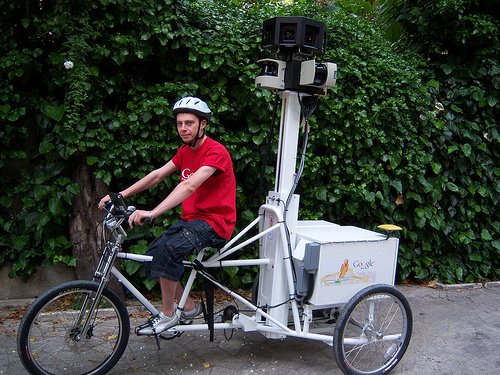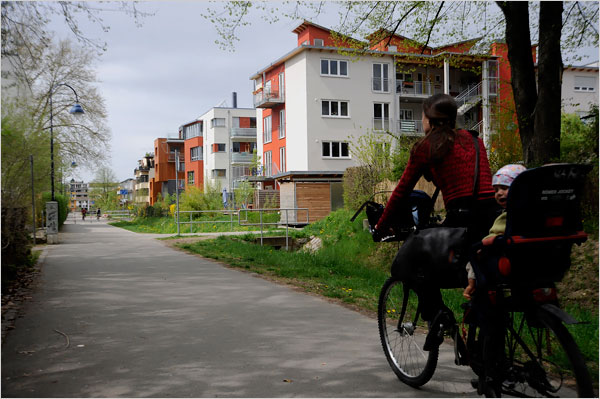Google takes to trikes for Street View

Google put out a press release yesterday about one of their Street View trikes. They must be newly in use in Europe as the Street View trikes have been seen out and about in the US already. Google stopped by RBR with one some months ago looking for a tune up.
Trike with a view
Google & VisitBritain poll British public for the best spots for the Street View Trike to visit this summer
We’ve heard from people around the UK that they’d like us to include even more images of our national tourist treasures in Street View and put Britain’s famous landmarks on the map. That’s why we’re giving people a sneak preview of our latest groundbreaking invention – the Google Trike. This mechanical masterpiece comprises 3 bicycle wheels, a mounted Street View camera and a specially decorated box containing image collecting gadgetry. It comes replete with a very athletic cyclist in customised Google apparel.
The Trikes have the same capability as Street View cars for collecting street-level imagery and are designed to help Google make special imagery collections in places less accessible by cars such as historic landmarks.
We can also reveal that we’re polling the British public for suggestions of extra special tourist spots, such as historic castles or famous landmarks, that the trike might visit. Google has teamed up with VisitBritain, with their unrivaled knowledge of Britain’s tourist treasures, to devise 5 categories under which people can submit their ideas. The categories are: Castles, Coastal paths, Natural Wonders, Historic Buildings & Monuments and (Sports) Stadiums. We’ll then work with VisitBritain to choose the most original ideas from each category. The public will then be able to cast their final votes to choose the top 3 locations the Google Trike will visit first.
People can send us their ideas via an online form linked to from: maps.google.co.uk/streetviewinfo As we only collect images from public roads we’ll work closely with the relevant organizations to collect images of privately-owned locations.
Justin Reid, Head of Online Marketing for VisitBritain said:
“We were only too happy to join forces with Google for the UK launch of Street View. The new trike will enable us to showcase even more of Britain’s wonderful destinations and we look forward to some great ideas from the public.”The trike will be starting in Genoa, Italy where we’ll be making the most of the good weather to collect images. The trike is expected to land on British shores later in the summer.
Due to operational factors such as light levels and the weather (and what could be a pretty tired cyclist), the trike will only be in the UK for a limited time during the summer. Images collected by the trike will be processed and carefully stitched together, a technological process that can take several months. They will be made available at a later date in Street View on Google Maps.
About Street View in UK
Street View is a hugely popular feature of Google Maps which is already available in more than 100 metropolitan areas around the world. It is also available in Google Earth and on Google Maps for Mobile. We launched Street View imagery in UK in April allowing people to view and navigate 360 degree street-level imagery in 25 British towns.
In areas where Street View is available, you can access street-level imagery by zooming into the lowest level on Google Maps, or by dragging the orange “Pegman” icon on the left-hand side of the map onto a blue highlighted street. You can check out a restaurant before arriving, make travel plans, arrange meeting points, get a helping hand with geography homework, or just explore and get to know your town better.
As well as consumers, UK businesses can also benefit from the Street View technology by embedding Google Maps directly into their site for free, helping them to promote a chain of hotels or increase awareness of a local library or restaurant.
Notes to editors
The trike weighs nearly 18 stone!
We will use specially trained super fit Google employees and contractors to ride the Trikes.
The “trikers” wear Google cycle helmets and clothing
There are 5 categories under which people can submit their ideas. The categories are: Castles, Coastal paths, Natural Wonders, Historic Buildings & Monuments and (Sports) Stadiums.
We will be accepting suggestions for a limited time and we’ll then work with Visit Britain to choose the most original ideas from each category. The public will then be able to cast their final votes and choose the top 3 locations we’ll try to add to Street View (pending sunny weather).
As we only collect images from public roads we’ll work closely with the relevant organizations to collect images of privately-owned locations.
As with all Street View imagery in the UK, we will apply our face-blurring and license plate blurring to all these images to protect people’s privacy. People will be able to report images for removal in the same way as they can now by clicking on ‘report a problem’ on the bottom left hand corner of the image. From here they complete a short form where they indicate the precise image to be removed
Press contact: Laura Scott, press-uk@google.com or 0207 031 3130


